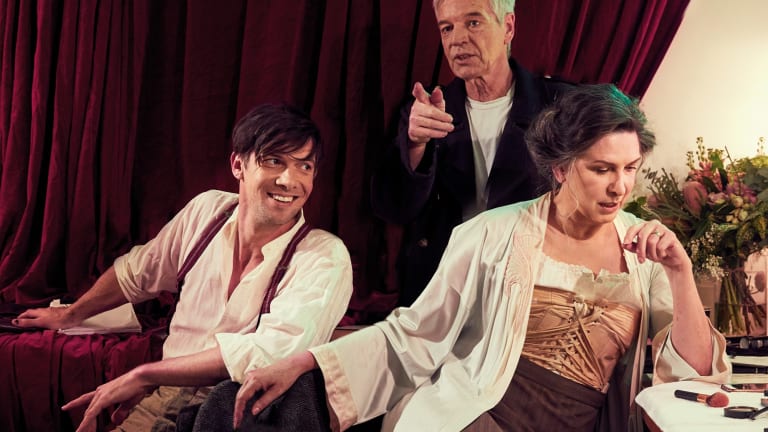The Dance of Death
Belvoir Theatre, November 14
★★★★½
Edgar and Alice are on the eve of their silver wedding anniversary. Cue cake, candles, champagne? Ah, but this is a match made in hell.
Toby Schmitz, Colin Friels and Pamela Rabe in The Dance of Death.Credit:Daniel Boud
The couple live in splenetic isolation on their windswept island in a dank fortress, a former prison. Their rancour is so toxic, even the walls seep blood and bile.
The elderly artillery captain and his former-actress wife know which scabs to pick to inflict maximum pain. They've turned their two children against them, loathe their neighbours and even their staff are deserting.
It sounds diabolical. It is. It is also savagely funny in this razor-sharp production directed by Judy Davis.
Into the couple's pas de deux of virtuosic vitriol steps Alice's cousin Kurt. He may have introduced the couple long ago. But nothing in this piece is what it initially seems.
Kurt arrives in evening dress, like a refugee from a Noel Coward play, looking as incongruous as the tropical palm tree cushion languishing on the chaise longue. He is fresh meat to the half-starved couple. Oh what fun they will have devouring him.
It is a production strong on gothic horror and melodrama. It offers a bold, bleak view of intimate relationships and the damage inflicted in an endless cycle of resentments, frustrations and manipulations.
Strindberg was all too familiar with unhappy wedlock. Two of this three disastrous marriages were already behind him when he wrote the play which he originally intended calling "The Vampire".
It abounds with references to vampirism and cannibalism. But who is the vampire? Each feeds off the other, while even hapless Kurt eventually goes for the jugular, literally.
Colin Friels as Edgar is a domestic tyrant, raging like King Lear with a dash of Alf Garnett. A despot with the soul of a slave, as Alice calls him. By the time he dances like a man possessed, the anguish beneath his arrogance is palpable. It is a riveting performance.
Pamela Rabe is outstanding as she channels the theatricality of the former actress Alice into her domestic stage. She veers between long-suffering, abused wife and Morticia-like vamp.
Comic and caustic, Friels and Rabe are exquisitely matched as they strip off the layers of contradictions.
Edgar craves annihilation but fears death. Alice wishes him dead and craves freedom. But when it seems her wish might be granted, it is Alice who telegraphs for help.
The ground between them shifts constantly. Do they want to destroy or dominate? Their cruel games have inflicted misery, but they have also revitalised them. Those games, the brawls and bawls have seen them endure. They know each other so frighteningly well.
Toby Schmitz as the initially restrained Kurt psychologically unravels in the face of their torment. He becomes their confidante, their toy – and Alice's love object – before he gathers the shreds of his sanity and flees for his life.
Giorgia Avery makes the most of her bit part as the slovenly maid.
All the design elements coalesce. Brian Thomson has created a superb set in which Count Dracula would feel at home. A small circular stage, which heightens the claustrophobia, is surrounded by oozing walls and a moat of blood in which floats the detritus of the combative couple's lives.
Composer Paul Charlier's sound design is full of metallic discord, relieved by some carnivalesque piano, while Matthew Scott's atmospheric lighting reveals and conceals the writing on the wall.
This influential 1900 play set the template for Who's Afraid of Virginia Woolf? and foreshadows Beckett's inseparable tramps; unable live together, unable to part.
This is a devil of a good production in which horror and dark humour pirouette endlessly.
Source: Read Full Article
